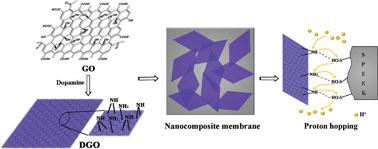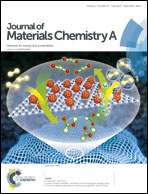Polydopamine-modified graphene oxide nanocomposite membrane for proton exchange membrane fuel cell under anhydrous conditions†
Abstract
A new approach to the facile preparation of anhydrous proton exchange membrane (PEM) enabled by artificial acid–base pairs is presented herein. Inspired by the bioadhesion of mussel, polydopamine-modified graphene oxide (DGO) sheets bearing –NH2 and –NH– groups are fabricated and then incorporated into sulfonated poly(ether ether ketone) (SPEEK) matrix to prepare the nanocomposite membrane. The DGO sheets are interconnected and homogeneously dispersed in SPEEK matrix, which provides unique rearrangement of the nanophase-separated structure and chain packing of nanocomposite membrane through interfacial electrostatic attractions. These attractions meanwhile induce the generation of acid–base pairs along the SPEEK–DGO interface, which then serve as long-range and low-energy-barrier pathways for proton hopping, imparting an enhanced proton transfer via the Grotthuss mechanism. In particular, under both hydrated and anhydrous conditions, the nanocomposite membrane exhibits much higher proton conductivity than the polymer control membrane. The enhanced proton conductivity results in the nanocomposite membrane having elevated cell performances under 120 °C and hydrous conditions, yielding a 47% increase in maximum current density and a 38% increase in maximum power density. Together with the stable conduction property, these results guarantee the nanocomposite membrane's promising prospects in high-performance fuel cell under anhydrous and elevated temperature conditions.


 Please wait while we load your content...
Please wait while we load your content...